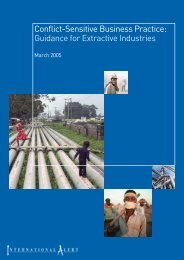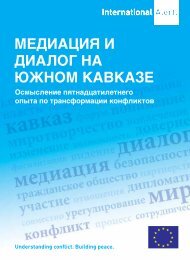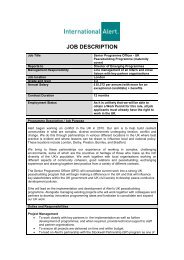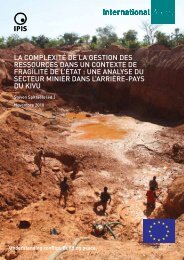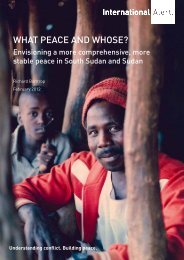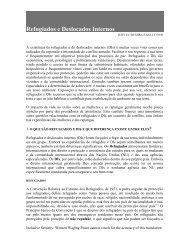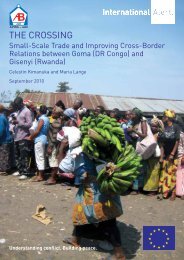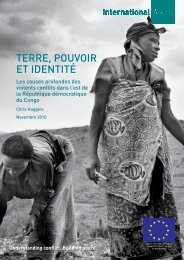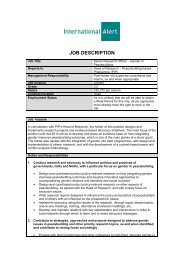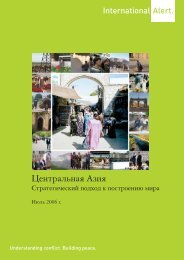The complexiTy of resource governance in a conTexT of sTaTe ... - Ipis
The complexiTy of resource governance in a conTexT of sTaTe ... - Ipis
The complexiTy of resource governance in a conTexT of sTaTe ... - Ipis
Create successful ePaper yourself
Turn your PDF publications into a flip-book with our unique Google optimized e-Paper software.
10 International Alert<br />
In addition to m<strong>in</strong><strong>in</strong>g sites, these maps show <strong>in</strong>formation on ownership, militia or army<br />
<strong>in</strong>volvement, the number <strong>of</strong> m<strong>in</strong>ers, m<strong>in</strong>eral prices and other variables. Guidel<strong>in</strong>es on their use<br />
are available onl<strong>in</strong>e at the same webpage. <strong>The</strong> follow<strong>in</strong>g chapters build on these maps.<br />
Difficulties encountered<br />
Carry<strong>in</strong>g out this k<strong>in</strong>d <strong>of</strong> research posed serious challenges <strong>in</strong> the DRC, where a number <strong>of</strong><br />
difficulties required manag<strong>in</strong>g.<br />
<strong>The</strong> first is the unreliability <strong>of</strong> exist<strong>in</strong>g data on the m<strong>in</strong><strong>in</strong>g sector. Official records are replete<br />
with <strong>in</strong>consistencies, gaps and mis<strong>in</strong>formation that make it impossible to pa<strong>in</strong>t a reliable and<br />
comprehensive picture <strong>of</strong> the trade. This is a region-wide phenomenon. In attempts to analyse this<br />
landscape, the one fact that analysts agree on is that there is no s<strong>in</strong>gle, reliable source <strong>of</strong> accurate<br />
data. 1 One <strong>of</strong> the major reasons is the omnipresence <strong>of</strong> illicit trade – particularly the trade <strong>in</strong><br />
gold, but also cassiterite, coltan and wolframite (tungsten ore) – along devious routes across the<br />
h<strong>in</strong>terland. <strong>The</strong> few <strong>of</strong>ficial statistics that do exist are not <strong>in</strong>tegrated between various government<br />
<strong>of</strong>fices due to communication and logistical challenges. Additionally, the paucity <strong>of</strong> registered<br />
comptoirs (<strong>of</strong>ficially recognised trad<strong>in</strong>g and export houses) means only a limited amount <strong>of</strong> the<br />
m<strong>in</strong>erals m<strong>in</strong>ed and sold appear on <strong>of</strong>ficial government records.<br />
As a rule, all statistics on trade should be approached with a healthy degree <strong>of</strong> caution – which does not<br />
mean they cannot be used. <strong>The</strong> data may not be sufficiently reliable to draw trustworthy conclusions,<br />
but it can confirm certa<strong>in</strong> trends when other <strong>in</strong>formation is also available. In <strong>in</strong>dividual chapters, the<br />
available data is discussed and some specific examples <strong>of</strong> reliability problems are given.<br />
A second challenge relates to field research <strong>in</strong> the DRC. Interviewees refer to many locations,<br />
but they have rarely visited them and <strong>of</strong>ten cannot provide precise <strong>in</strong>formation on their location.<br />
This is particularly true for m<strong>in</strong><strong>in</strong>g sites. <strong>The</strong> names <strong>of</strong> some m<strong>in</strong><strong>in</strong>g sites feature on lists provided<br />
by the Division des M<strong>in</strong>es or the Service d’assistance et d’encadrement du small-scale m<strong>in</strong><strong>in</strong>g<br />
(SAESSCAM), but little or no <strong>in</strong>formation is available on their precise location. <strong>The</strong>re are several<br />
reasons for this: lack <strong>of</strong> centralised data collection by prov<strong>in</strong>cial authorities and m<strong>in</strong><strong>in</strong>g agencies;<br />
difficult access due to poor roads; and bouts <strong>of</strong> <strong>in</strong>security. <strong>The</strong> only way to address the problem is<br />
by visit<strong>in</strong>g the site with a GPS device, an approach the authors adopted as far as possible with<strong>in</strong><br />
their timeframe constra<strong>in</strong>ts.<br />
Related to the previous challenge is the problem <strong>of</strong> reach<strong>in</strong>g very remote m<strong>in</strong><strong>in</strong>g areas or m<strong>in</strong><strong>in</strong>g<br />
areas that are located <strong>in</strong> <strong>in</strong>secure areas. Local researchers acqua<strong>in</strong>ted with the region and its<br />
people were able to travel relatively easy to areas an expatriate would rarely reach, but there<br />
were a number <strong>of</strong> places that <strong>in</strong>security rendered <strong>of</strong>f-limits even to them. For each <strong>of</strong> the three<br />
h<strong>in</strong>terland areas, the text expla<strong>in</strong>s which sites not even the local researchers could visit.<br />
A fourth challenge was the difficulty <strong>of</strong> measur<strong>in</strong>g the relative importance <strong>of</strong> m<strong>in</strong><strong>in</strong>g sites, which is<br />
crucial to any analysis <strong>of</strong> the h<strong>in</strong>terland m<strong>in</strong><strong>in</strong>g sector. Work<strong>in</strong>g with production figures provided<br />
by the <strong>in</strong>terviewees was not a reliable option. One cannot assess such <strong>in</strong>formation without<br />
spend<strong>in</strong>g some significant time on each site <strong>in</strong> order to observe the production cha<strong>in</strong> and to<br />
speak to the various <strong>in</strong>dividuals <strong>in</strong>volved. Interviewees may <strong>in</strong>flate production figures to attract<br />
potential foreign <strong>in</strong>vestors and donors or, alternatively, they may lower them out <strong>of</strong> concern for<br />
any potential <strong>in</strong>crease <strong>in</strong> taxes or hostile commercial <strong>in</strong>terest.<br />
An alternative approach – compar<strong>in</strong>g the number <strong>of</strong> artisanal m<strong>in</strong>ers at the different sites – was<br />
used to produce more objective data. However, this method also has flaws. Estimates <strong>of</strong> m<strong>in</strong>ers<br />
are difficult to obta<strong>in</strong> s<strong>in</strong>ce they fluctuate accord<strong>in</strong>g to a site’s pr<strong>of</strong>itability (driven by outside<br />
1 Pact Inc. (June 2007) Research<strong>in</strong>g Natural Resources and Trade Flows <strong>in</strong> the Great Lakes Region, DFID/USAID/COMESA, p. 5.





